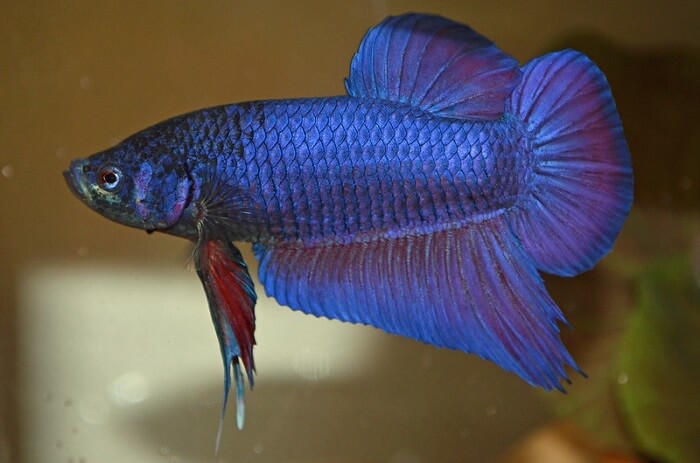
Breed Overview
| Origin | Thailand, Vietnam, Cambodia, and Laos |
| Lifespan | 2-5 years |
| Size | 2-3”/7-8cm |
| Colour | Purple (can be bicolor) |
| Food | Carnivorous |
| Tank Size | Minimum 20 gallons/76 liters |
| Temperament | Intelligent, curious, yet can be aggressive |
| Water Type | Freshwater |
| Water Temperature | 74-82F/23-28C |
| Water pH | 7 (can range from 6.5-7.5) |
| Difficulty Level | Intermediate |
Species Summary
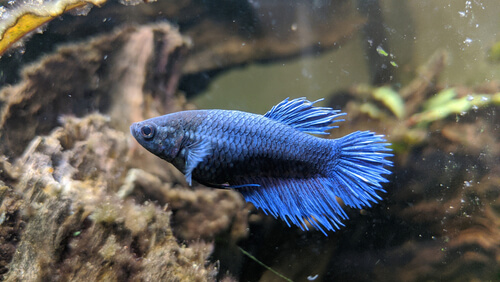
The betta fish was originally bred from wild fish that live in the rice paddies of southeast Asia, and now there are a huge variety of different colors and tail morphs to choose from. The betta fish demonstrates sexual dimorphism, meaning the male and the female look very different.
Males tend to be showier and are the sex of fish that is known for their flowing fins, and the purple betta is no different. However, female purple betta fish also exist and either of them can make a spectacular choice for any aquarium.
Appearance
The purple betta fish does not differ from other varieties much except for its striking color. In fact, it can come in any of the varieties that a red or blue betta can – such as Halfmoon, crown tail, veil tail, or plakat. However, its rarity means it may take longer to find a purple betta of your variety of choice.
How To Tell If You Have A True Purple Betta Fish
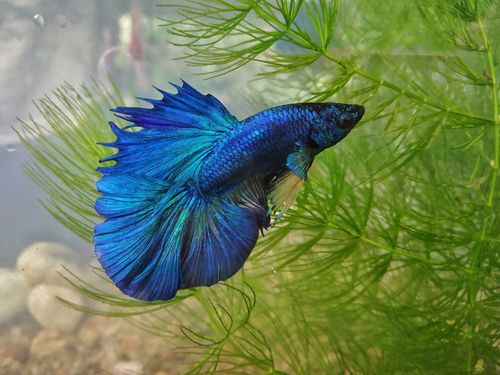
Due to the rarity of the purple betta, occasionally others are passed off as one. A genuine purple betta fish will be a vivid royal purple. There will be no hints of blue – and, most importantly, it won’t change color under light.
Tank Setup And Maintenance
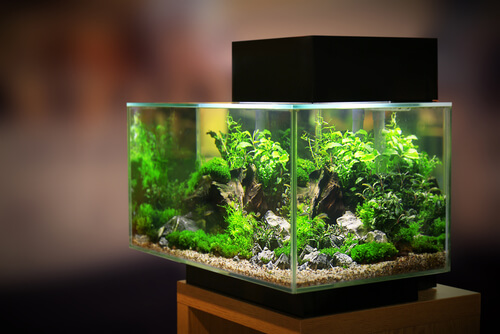
1. Basic parameters
| Size | Minimum 20 gallons (76 liters) |
| pH | Neutral |
| Water hardness | 3-4 dGh |
| Temperature | 74-82F/23-28C |
| Ammonia and Nitrates | zero |
| Filter | Flow rate 4x tank capacity, sponge filter |
| Water changes | 20% every 1-2 weeks |
2. Planting Your Tank
Planting a betta tank can be really fun, but it’s also great for your fish as they love to hide in and amongst plants. By planting plants in clumps with space between them and adding driftwood, rocks, and places for your fish to explore, you will have a happy, healthy betta that does not feel territorially threatened.
3. Sorority Tanks And Female Purple Betta Fish
A sorority tank of 5-6 female bettas can be great providing it is set up correctly. This means giving enough separate areas of territory so that all your fish have enough space. This helps prevent hierarchy disputes. Likewise, start with 20 gallons (76 liters) of water for one fish and add an extra 10 gallons (38 liters) per extra fish.
Author’s Note: You may have heard that betta fish are aggressive, but in truth, their social habits are more complex than this, and with female betta fish in particular, studies have shown they often prefer each others’ company to an empty tank!
4. Other Suitable Tankmates
Other suitable tankmates are those that come from a similar tropical environment and need similar temperature requirements, but that don’t share tank territory with the betta.
This means that bottom-dwelling fish, as well as schooling fish, are amazing choices for any purple betta fish tank. Cory catfish, kuhli loaches, and harlequin rasboras are all suitable additions.
Feeding
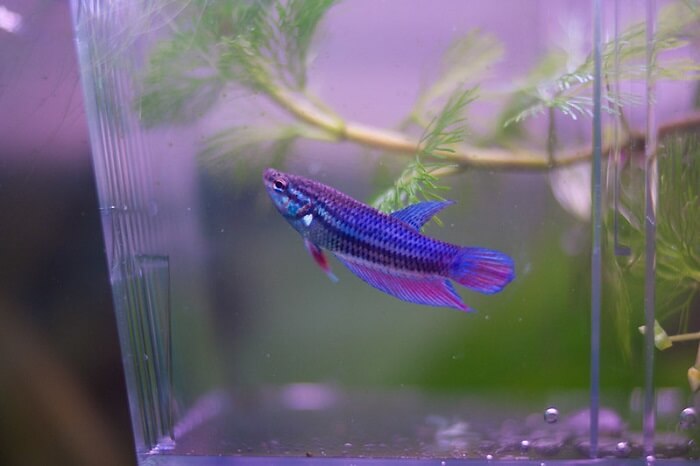
Unlike many tropical freshwater fish, betta fish are actually obligate carnivores, meaning they only eat meat. If this sounds tricky, don’t worry, as betta-formulated flakes and pellets will ensure your fish gets all the vitamins and minerals they need.
However, to enrich your fish’s diet, it’s good to feed both fresh and frozen protein, which can be found in any big aquatics center and mostly consists of invertebrates. Good choices include:
- Tubifex worms
- Brine shrimp
- Daphnia
- Vinegar eels
- Bloodworms
You can also very occasionally feed bits of chopped-up salmon or beef heart.
What To Do If Your Betta Fish Is Not Eating
If your betta fish is not eating, your first thought might be that your fish is sick. Indeed, with their long flowing fins, these fish can look delicate. However, did you know that betta fish can also be picky eaters?
If your fish is not eating, checking the water for ammonia and nitrates can rule out whether this is to do with sickness or stress. However, offering different foods can entice your betta to eat. This is very important as a betta cannot go long without food.
There are other reasons your betta may not eat, such as if your female betta is gravid with eggs. However, if your fish shows no other signs of illness, it may simply be seeking more variety.
Behavior And Temperament
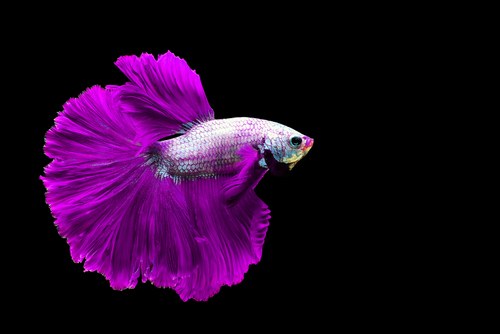
The purple betta fish is similar in behavior to other varieties. It’s a curious, active fish that likes to explore its environment. However, that’s not to say that your fish’s color doesn’t influence behavior at all. It’s been discovered that in a community tank of female betta fish, bettas will swim near fish of their own color.
In the wild, it would have been beneficial for fish to disguise their coloring to hide from predators. So, if you do have a female purple betta fish that sticks out in a sorority tank, ensure your tank has lots of hiding places. Likewise, spotting any changes in behavior such as lethargy or if your betta fish is not moving is very important. These can be a sign your betta is sick or about to die.
1. Purple Betta Fish Female And Male Behavior Differences
Occasionally, a male betta fish may flare his fins at the glass. This is a display of aggression, as the male betta sees its appearance and believes there is another fish taking over its territory. It’s best not to encourage this, as it can actually stress your fish out.
Meanwhile, in female sorority tanks, you may see fish nip at each other and this is generally to establish a hierarchy or a territorial dispute. This is generally prevented by starting with a tank that is big enough!
2. Signs Your Betta Fish Is Happy
After getting your betta fish home, you may wonder how you can tell that it is settling in correctly. The journey home from the pet shop can be stressful for fish, so it’s good to give them some time to acclimatize. However, if you’re wondering how to spot that your fish is happy, look out for the following signs:
In male betta fish, including the purple betta fish male, blowing a bubble nest is a surefire sign that your fish is in top condition. The male betta fish uses this display to indicate to any potential females that he is ready to mate.
Apart from this, swimming around in all parts of the tank, showing an interest in plants, surroundings, and things going on beyond the tank glass also show your fish is happy for both males and females.
Author’s Note: For female betta fish, sometimes it can be harder to tell as they don’t build nests. Yet apathy from looking out for the same signs, if your fish is in a sorority tank, peaceful cohabitation with other female bettas is a sure sign that you’ve done everything right.
Pests And Diseases
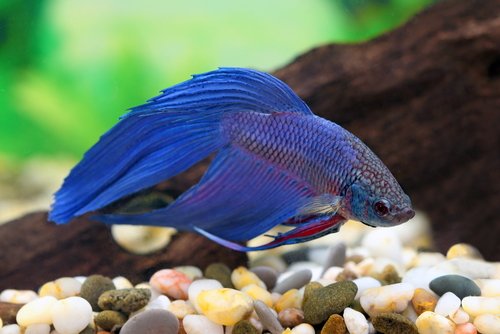
1. Betta Fish Purple Color Change
One of the more alarming things to see in your tank is your betta fish losing or changing color. Did you know that in betta fish, pigmentation is actually correlated with immune health?
In fact, betta fish cannot synthesize carotenoids, the color-producing pigments, on their own, so they have to get them from food. If your fish is sick it may be that they don’t have the energy to both produce pigment and fight off infection.
Therefore take any color change as a sign to test the water and look out for other disease symptoms. In addition, it might be that your fish is malnourished. You may have to change the pellets you are using or enrich their diet with live or frozen protein.
As a rule of thumb, pellets ensure balanced nutrition – but an enriched diet is always better to let your fish reach optimum health.
2. Velvet Disease
Velvet disease is a parasite that causes an unusual-looking, gold-flecked, velvety coating on your fish’s scales. It’s important not to mistake it at first for part of your fish’s natural coloring as a result. Fortunately, velvet disease is easy to treat with over-the-counter medication. However, like with any fish disease, it’s best to also look at the underlying cause.
Velvet disease is most often caused by poor water conditions, It’s best to test the water for ammonia and nitrates and check whether the filter is working, or if there is any uneaten food left, too.
3. Fin Rot
Fin rot is an infection that can be caused by several species of bacteria and causes sore, ragged patches on your fish’s fins. It may be that you notice this one very quickly with your purple betta fish due to their magnificent coloring. As soon as this is the case, you can easily treat it with over-the-counter medication.
Breeding
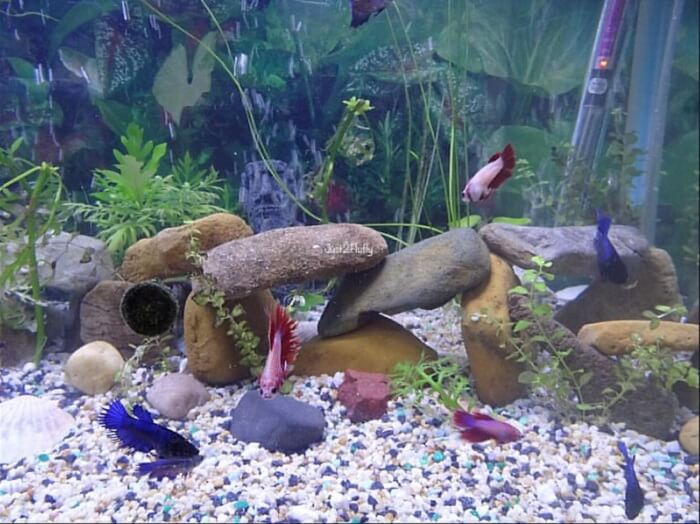
It is well known amongst aquarists that betta fish that are fed well will thrive more overall in every aspect, and nowhere is this more apparent than when breeding. In fact, scientists found that betta fish that were fed on live, protein-rich foods such as bloodworms produced stronger offspring than those that were only fed pellets.
Betta Fish Breeding Overview
Breeding purple betta fish is much like breeding any other betta fish variety. If you’re not already experienced with breeding easier species, it might not be good to start with betta fish. However, if you are familiar with the setup of a breeding tank and have an idea of how betta fish mate, here are the main things to note when breeding bettas:
- Always have a tank divider to separate the male and the female before you introduce them both.
- Make sure you have enough space and tanks for the individual fish. That means a tank for the male, a tank for the female, a breeding tank, and a tank for the fry or juvenile betta fish. Some of these can be interchanged but the main part is that you are separating the fish when needed.
Signs that your male and female purple betta fish are ready to mate:
- Like all betta fish females, your purple betta fish female with develop vertical stripes on her body when ready to mate. This generally happens in response to her seeing the male, who may, in turn, be ‘flirting’ by waving his fins at her
- Once this has happened, you can be sure it is safe to introduce your fish. The male and female betta will wrap their bodies around each other as part of the courtship, the female will drop her eggs, and the male will fertilize them. This takes place after the male has built a bubble nest.
- Once mating has happened, the male purple betta fish will guard the bubble nest against any form of threat. This generally includes the female betta, who is at risk of eating the eggs. Therefore as soon as mating has happened, it’s best to remove the female to prevent aggression.
Caring For Betta Fish Fry:
A lot of the work of caring for the eggs and fry will be done for you by the purple betta fish male! In fact, one of the best parts of breeding betta fish is watching the male’s devoted parenting. He will pick up any eggs or fry that fall from the bubble nest, and gently place them back.
You can remove the male from the breeding tank back to his own tank once the fry are old enough to be fed on solid foods. For the first few days, they are still attached to the yolk sacks of their eggs, which they feed on.
After this, you can feed them on infusoria, which is a specially prepared, commercially available mix of invertebrates like plankton, protozoa, and brine shrimp larvae that is small enough for the betta fry to fit in their mouths.
Author’s Note: When your betta fry are about two months old, you need to do a process known as ‘jarring’ them. This means separating the males into separate containers to prevent them from fighting each other. At this point, your fish’s colors will be developing. Betta fish reach sexual maturity at around 4 months of age. However, they do not fully stop growing until they are a year old.
Final Thoughts
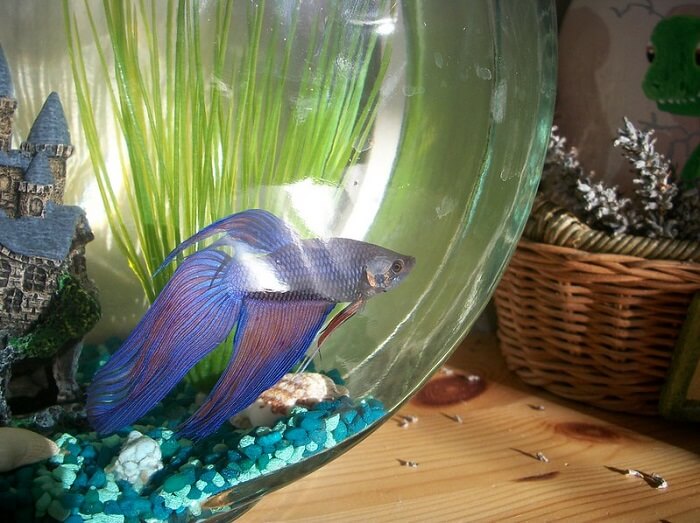
The purple betta fish may be hard to come by, but it’s definitely worthwhile keeping an eye out for one of these stunning and unusual fish. All betta fish have dramatic fins and colors, but if you want something a little different than the basic red or blue bettas found in pet stores, a purple betta fish might be just what you’re looking for…




